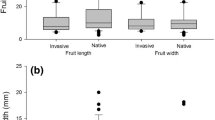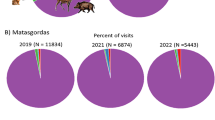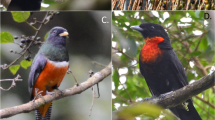Abstract
Indirect interactions among plant species mediated by frugivorous animals can be central to population and community dynamics, since the successful seed dispersal of species may depend on facilitative or competitive interactions with heterospecific plants. Yet, empirical evidence on these interactions is very scarce and mostly available at small spatial scales, within populations. Because lipid-rich fruits are known to be preferred by migratory birds, here we test our prediction of competitive inferiority of a carbohydrate-rich fruited species (the hawthorn Crataegus monogyna) compared to lipid-rich co-fruiting species in a Mediterranean region where the bulk of seed dispersal relies on migratory birds. We assessed avian seed dispersal in both relative (fruit removal rate) and absolute terms (seed dispersal magnitude) in seven hawthorn populations distributed across an altitudinal gradient encompassing three contrasting fruiting contexts: hawthorn is scarce in the lowlands, common in the midlands, and the dominant fruit species in the highlands. We found evidence of seed dispersal reduction due to interspecific competition in the lowland populations, where lipid-rich fruits dominate. Besides, DNA barcoding analysis of bird-dispersed seeds revealed that only a small subset of the local frugivore assemblages consumed hawthorn fruits in the lowland communities. Instead, the consumers of hawthorn fruits resembled the local frugivore assemblages where hawthorn fruits were more dominant and frugivore choices more limited. Our study suggests mechanisms by which the rarity or dominance of plant species might be jointly influenced by environmental constraints (here, precipitation along the altitudinal gradient) and frugivore-mediated indirect interactions among plants hindering or facilitating seed dispersal.




Similar content being viewed by others
References
AEMET-IM (2011) Atlas climático ibérico—Iberian climate atlas. Agencia Estatal de Meteorología, Ministerio de Medio Ambiente y Rural y Marino/Instituto de Meteorologia de Portugal, Madrid
Afik D, Karasov WH (1995) The trade-offs between digestion rate and efficiency in warblers and their ecological implications. Ecology 76:2247–2257
Albrecht J, Bohle V, Berens DG, Jaroszewicz B, Selva N, Farwig N (2015) Variation in neighbourhood context shapes frugivore-mediated facilitation and competition among co-dispersed plant species. J Ecol 103:526–536. https://doi.org/10.1111/1365-2745.12375
Bairlein F (1990) Nutrition and food selection in migratory birds. In: Gwinner E (ed) Bird migration: physiology and ecophysiology. Springer, New York, pp 198–213
Bimler MD, Stouffer DB, Lai HR, Mayfield MM (2018) Accurate predictions of coexistence in natural systems require the inclusion of facilitative interactions and environmental dependency. J Ecol 106:1839–1852
Carlo TA (2005) Interspecific neighbors change seed dispersal pattern of an avian-dispersed plant. Ecology 86:2440–2449. https://doi.org/10.1890/04-1479
Carlo TA, Morales JM (2016) Generalist birds promote tropical forest regeneration and increase plant diversity via rare-biased seed dispersal. Ecology 97:1819–1831
Carlo TA, Collazo JA, Groom MJ (2003) Avian fruit preferences across a Puerto Rican forested landscape: pattern consistency and implications for seed removal. Oecologia 134:119–131
Christensen KI (1992) Revision of Crataegus sect. Crataegus and nothosect. Crataeguineae (Rosaceae–Maloideae) in the Old World. Syst Bot Monogr 35:1–199
Darwin C (1859) On the origin of species by means of natural selection, or the preservation of favoured races in the struggle for life. Murray, J., London
Donoso I, García D, Martínez D, Tylianakis JM, Stouffer DB (2017) Complementary effects of species abundances and ecological neighborhood on the occurrence of fruit–frugivore interactions. Front Ecol Evol 5:133
García D, Martínez D (2012) Species richness matters for the quality of ecosystem services: a test using seed dispersal by frugivorous birds. Proc R Soc Lond Ser B Biol Sci. https://doi.org/10.1098/rspb.2012.0175
García D, Ortiz-Pulido R (2004) Patterns of resource tracking by avian frugivores at multiple spatial scales: two case studies on discordance among scales. Ecography 27:187–196
García D, Zamora R, Gómez JM, Hódar JA (2001) Frugivory at Juniperus communis depends more on population characteristics than on individual attributes. J Ecol 89:639–647
García D, Obeso JR, Martinez I (2005) Spatial concordance between seed rain and seedling establishment in bird-dispersed trees: does scale matter? J Ecol 93:693–704
García D, Martínez I, Obeso JR (2007) Seed transfer among bird-dispersed trees and its consequences for post-dispersal seed fate. Basic Appl Ecol 8:533–543
Ghazoul J (2006) Floral diversity and the facilitation of pollination. J Ecol 94:295–304. https://doi.org/10.1111/j.1365-2745.2006.01098.x
González-Varo JP (2010) Fragmentation, habitat composition and the dispersal/predation balance in interactions between the Mediterranean myrtle and avian frugivores. Ecography 33:185–197
González-Varo JP, Traveset A (2016) The labile limits of forbidden interactions. Trends Ecol Evol 31:700–710. https://doi.org/10.1016/j.tree.2016.06.009
González-Varo JP, Arroyo JM, Jordano P (2014) Who dispersed the seeds? The use of DNA barcoding in frugivory and seed dispersal studies. Methods Ecol Evol 5:806–814. https://doi.org/10.1111/2041-210X.12212
González-Varo JP, Carvalho CS, Arroyo JM, Jordano P (2017) Unravelling seed dispersal through fragmented landscapes: frugivore species operate unevenly as mobile links. Mol Ecol 26:4309–4321. https://doi.org/10.1111/mec.14181
Guo Q, Taper M, Schoenberger M, Brandle J (2005) Spatial–temporal population dynamics across species range: from centre to margin. Oikos 108:47–57
Hacker SD, Gaines SD (1997) Some implications of direct positive interactions for community species diversity. Ecology 78:1990–2003
Hampe A (2008) Fruit tracking, frugivore satiation, and their consequences for seed dispersal. Oecologia 156:137–145. https://doi.org/10.1007/s00442-008-0979-0
Herrera CM (1982) Seasonal variation in the quality of fruits and diffuse coevolution between plants and avian dispersers. Ecology 63:773–785
Herrera CM (1984a) Adaptation to frugivory of Mediterranean avian seed dispersers. Ecology 65:609–617. https://doi.org/10.2307/1941423
Herrera CM (1984b) Seed dispersal and fitness determinants in wild rose: combined effects of hawthorn, birds, mice, and browsing ungulates. Oecologia 63:386–393. https://doi.org/10.1007/bf00390670
Herrera CM (1987) Vertebrate-dispersed plants of the Iberian Peninsula: a study of fruit characteristics. Ecol Monogr 57:305–331. https://doi.org/10.2307/2937089
Herrera CM (2002) Seed dispersal by vertebrates. In: Herrera CM, Pellmyr O (eds) Plant–animal interactions. An evolutionary approach. Blackwell Science, Oxford, pp 185–208
Holt RD (1984) Spatial heterogeneity, indirect interactions, and the coexistence of prey species. Am Nat 124:377–406
Hurlbert SH (1978) The measurement of niche overlap and some relatives. Ecology 59:67–77. https://doi.org/10.2307/1936632
Izhaki I (2002) The role of fruit traits in determining fruit removal in East Mediterranean ecosystems. In: Levey DJ, Silva WR, Galetti M (eds) Seed dispersal and frugivory: ecology, evolution, and conservation. CABI Publishing, Wallingford, pp 161–176
Jordano P (2014) Fruits and frugivory. In: Gallagher RS (ed) Seeds: the ecology of regeneration of plant communities, 3rd edn. CABI, Wallingford, pp 18–61
Jordano P, Schupp EW (2000) Seed disperser effectiveness: the quantity component and patterns of seed rain for Prunus mahaleb. Ecol Monogr 70:591–615. https://doi.org/10.1890/0012-9615(2000)070%5b0591:sdetqc%5d2.0.co;2
Jordano P, García C, Godoy JA, García-Castaño JL (2007) Differential contribution of frugivores to complex seed dispersal patterns. Proc Natl Acad Sci USA 104:3278–3282. https://doi.org/10.1073/pnas.0606793104
Levey DJ, Martínez del Rio C (2001) It takes guts (and more) to eat fruit: lessons from avian nutritional ecology. Auk 118:819–831
Levine JM, Murrell DJ (2003) The community-level consequences of seed dispersal patterns. Annu Rev Ecol Evol Syst 34:549–574. https://doi.org/10.2307/30033786
López-Bao JV, González-Varo JP (2011) Frugivory and spatial patterns of seed deposition by carnivorous mammals in anthropogenic landscapes: a multi-scale approach. PLoS One 6:e14569
Mack RN, Harper JL (1977) Interference in dune annuals: spatial pattern and neighbourhood effects. J Ecol 65:345–363
Martínez I, García D, Obeso JR (2008) Differential seed dispersal patterns generated by a common assemblage of vertebrate frugivores in three fleshy-fruited trees. Ecoscience 15:189–199. https://doi.org/10.2980/15-2-3096
Martínez D, García D, Herrera JM (2014) Consistency and reciprocity of indirect interactions between tree species mediated by frugivorous birds. Oikos 123:414–422. https://doi.org/10.1111/j.1600-0706.2013.00558.x
Matías L, Gómez-Aparicio L, Zamora R, Castro J (2011) Effects of resource availability on plant recruitment at the community level in a Mediterranean mountain ecosystem. Perspect Plant Ecol Evol Syst 13:277–285. https://doi.org/10.1016/j.ppees.2011.04.005
Matías L, Zamora R, Castro J (2012) Sporadic rainy events are more critical than increasing of drought intensity for woody species recruitment in a Mediterranean community. Oecologia 169:833–844. https://doi.org/10.1007/s00442-011-2234-3
Moran C, Catterall CP, Kanowski J (2009) Reduced dispersal of native plant species as a consequence of the reduced abundance of frugivore species in fragmented rainforest. Biol Conserv 142:541–552. https://doi.org/10.1016/j.biocon.2008.11.006
Morán-López T, Carlo TA, Amico G, Morales JM (2018a) Diet complementation as a frequency-dependent mechanism conferring advantages to rare plants via dispersal. Funct Ecol 32:2310–2320. https://doi.org/10.1111/1365-2435.13152
Morán-López T, Carlo TA, Morales JM (2018b) The role of frugivory in plant diversity maintenance–a simulation approach. Ecography 41:24–31
Paine RT (1980) Food webs: linkage, interaction strength and community infrastructure. J Anim Ecol 49:667–685
R Development Core Team (2015) R: a language and environment for statistical computing. R Foundation for Statistical Computing, Vienna. http://www.R-project.org/
Ratnasingham S, Hebert PDN (2007) bold: The Barcode of Life Data System (http://www.barcodinglife.org). Mol Ecol Notes 7:355–364. https://doi.org/10.1111/j.1471-8286.2007.01678.x
Ripple WJ, Beschta RL (2012) Trophic cascades in Yellowstone: the first 15 years after wolf reintroduction. Biol Conserv 145:205–213
Roemer GW, Donlan CJ, Courchamp F (2002) Golden eagles, feral pigs, and insular carnivores: how exotic species turn native predators into prey. Proc Natl Acad Sci USA 99:791–796. https://doi.org/10.1073/pnas.012422499
Saracco JF, Collazo JA, Groom MJ, Carlo TA (2005) Crop size and fruit neighborhood effects on bird visitation to fruiting Schefflera morototoni trees in Puerto Rico. Biotropica 37:81–87. https://doi.org/10.1111/j.1744-7429.2005.04040.x
Schaefer HM, Valido A, Jordano P (2014) Birds see the true colours of fruits to live off the fat of the land. Proc R Soc B 281:20132516
Schupp EW, Jordano P, Gómez JM (2010) Seed dispersal effectiveness revisited: a conceptual review. New Phytol 188:333–353. https://doi.org/10.1111/j.1469-8137.2010.03402.x
Simmons BI et al (2018) Moving from frugivory to seed dispersal: incorporating the functional outcomes of interactions in plant–frugivore networks. J Anim Ecol 87:995–1007
Snow B, Snow D (1988) Birds and berries. T and A D Poyser, Calton
Stiles EW (1980) Patterns of fruit presentation and seed dispersal in bird-disseminated woody plants in the eastern deciduous forest. Am Nat 116:670–688
Stiles EW (1993) The influence of pulp lipids on fruit preference by birds. In: Fleming TH, Estrada A (eds) Frugivory and seed dispersal: ecological and evolutionary aspects. Springer Netherlands, Dordrecht, pp 227–235
Tellería JL, Asensio B, Díaz M (1999) Aves Ibéricas II, Paseriformes edn. Reyero, Madrid
Tellería JL, Ramírez A, Pérez-Tris J (2008) Fruit tracking between sites and years by birds in Mediterranean wintering grounds. Ecography 31:381–388. https://doi.org/10.1111/j.2008.0906-7590.05283.x
Traveset A, González-Varo JP, Valido A (2012) Long-term demographic consequences of a seed dispersal disruption. Proc R Soc B 279:3298–3303
Wang BC, Smith TB (2002) Closing the seed dispersal loop. Trends Ecol Evol 17:379–386. https://doi.org/10.1016/S0169-5347(02)02541-7
Whelan CJ, Schmidt KA, Steele BB, Quinn WJ, Dilger S (1998) Are bird-consumed fruits complementary resources? Oikos 83:195–205. https://doi.org/10.2307/3546561
Witmer M, Van Soest P (1998) Contrasting digestive strategies of fruit-eating birds. Funct Ecol 12:728–741
Wootton JT (1994) The nature and consequences of indirect effects in ecological communities. Annu Rev Ecol Syst 25:443–466
Wootton JT (2002) Indirect effects in complex ecosystems: recent progress and future challenges. J Sea Res 48:157–172
Xiao Z, Zhang Z (2016) Contrasting patterns of short-term indirect seed–seed interactions mediated by scatter-hoarding rodents. J Anim Ecol 85:1370–1377
Yang S, Ferrari MJ, Shea K (2011) Pollinator behavior mediates negative interactions between two congeneric invasive plant species. Am Nat 177:110–118
Acknowledgements
We thank the ‘Parque Natural Sierra de Grazalema’ for the permission to work in this protected area and the ‘Servicio de Cría Caballar de las Fuerzas Armadas’ for permission to work at ‘Garrapilos’. We also thank Pedro Jordano for his feedback on this study. Benno Simmons kindly checked the English grammar and style. Logistical support was provided by the Molecular Ecology Laboratory, Estación Biológica de Doñana (LEM-EBD-CSIC), a facility certified to ISO9001:2015 and ISO14001:2015 quality and environmental management protocols. JPGV and this study were funded by a Severo Ochoa Award for Centres of Excellence in R + D + I (SEV-2012-0262). While writing this paper, JPGV and BR were funded by the ‘Rei Jaume I’ awarded to Prof. Anna Traveset (Institut Mediterrani d’Estudis Avançats, CSIC- UIB). JPGV was also funded by an Individual Fellowship from the Marie Sklodowska-Curie Actions (H2020-MSCA- IF-2014-656572: MobileLinks). We also acknowledge the Spanish ‘Juan de la Cierva Incorporación’ and ‘Ramón y Cajal’ Programmes that currently fund the research activity of BR (IJCI-2017-33475) and JPGV (RYC-2017-22095), respectively.
Author information
Authors and Affiliations
Contributions
JPGV conceived and designed the study. MAV and JPGV collected field data. JMA conducted laboratory work. BR and JPGV led the data analysis. BR, MAV and JPGV drafted the manuscript. All authors commented on manuscript drafts and gave the final approval for publication.
Corresponding author
Additional information
Communicated by Paulo Guimaraes.
Electronic supplementary material
Below is the link to the electronic supplementary material.
Rights and permissions
About this article
Cite this article
Rumeu, B., Álvarez-Villanueva, M., Arroyo, J.M. et al. Interspecific competition for frugivores: population-level seed dispersal in contrasting fruiting communities. Oecologia 190, 605–617 (2019). https://doi.org/10.1007/s00442-019-04434-9
Received:
Accepted:
Published:
Issue Date:
DOI: https://doi.org/10.1007/s00442-019-04434-9




